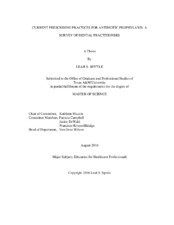| dc.description.abstract | Antibiotic prophylaxis, administered prior to dental treatment, has been important in the prevention of infective endocarditis. The American Heart Association (AHA) and the American Academy of Orthopaedic Surgeons (AAOS) have developed guidelines for the use of antibiotic prophylaxis in healthcare and dentistry. However, various changes in the antibiotic prophylaxis guidelines in recent years have caused confusion for many healthcare providers, dentists, and patients. Currently, there is limited research on United States dental practitioner’s prescribing practices of antibiotic prophylaxis. The purpose of this study was to examine whether dental practitioners in Texas, Oklahoma, and Kansas were following the 2007 guidelines of the AHA and AAOS regarding the use of antibiotic prophylaxis. A questionnaire was sent to 600 dentists in varying areas of dental practice with a response rate of 28.7% (n=172). Data analysis was performed using descriptive statistics, weighted logistic regression, and quadratic polynomial regression analysis. In addition, a scoring system was created to analyze dentists’ antibiotic prophylaxis prescribing practices for specific survey questions. This study found that 56% (n=97) of the respondents were following the current 2007 AHA antibiotic prophylaxis guidelines. Results of this study also revealed that 71.7% (n=119) of respondents prescribed antibiotic prophylaxis within the first two years after total prosthetic joint replacement, while 57.8% (n=96) continued to prescribe antibiotic prophylaxis beyond two years. The respondents of this study were asked if the patient was an integral part of the decision making process when discussing an antibiotic prophylaxis regimen. The majority of respondents (72.4%, n=123) stated that the patient was included in the decision to take antibiotic prophylaxis if needed. In regard to antibiotic resistance, the majority of respondents (73.2%, n=120) stated they believed there is a risk for antibiotic resistance if a patient is taking the required antibiotic prophylaxis regimen for each dental visit. Approximately 92% (n=155) of respondents believed there was confusion regarding antibiotic prophylaxis protocols used in dentistry, specifically including data suggesting that dentists and physicians do not agree on which conditions should be covered prophylactically. Future studies need to include a larger sample size to determine compliance with antibiotic prophylactic guidelines. | en |


